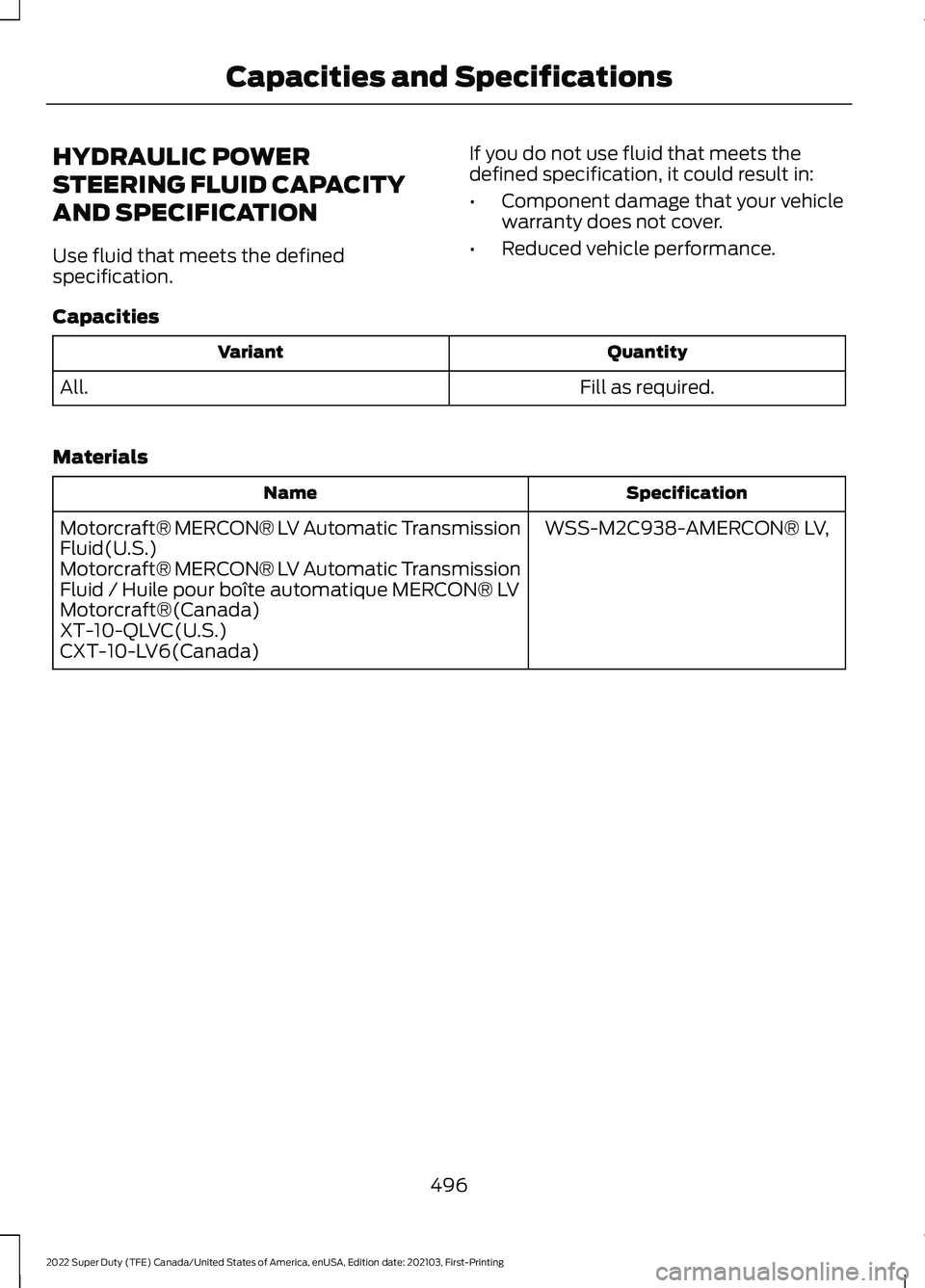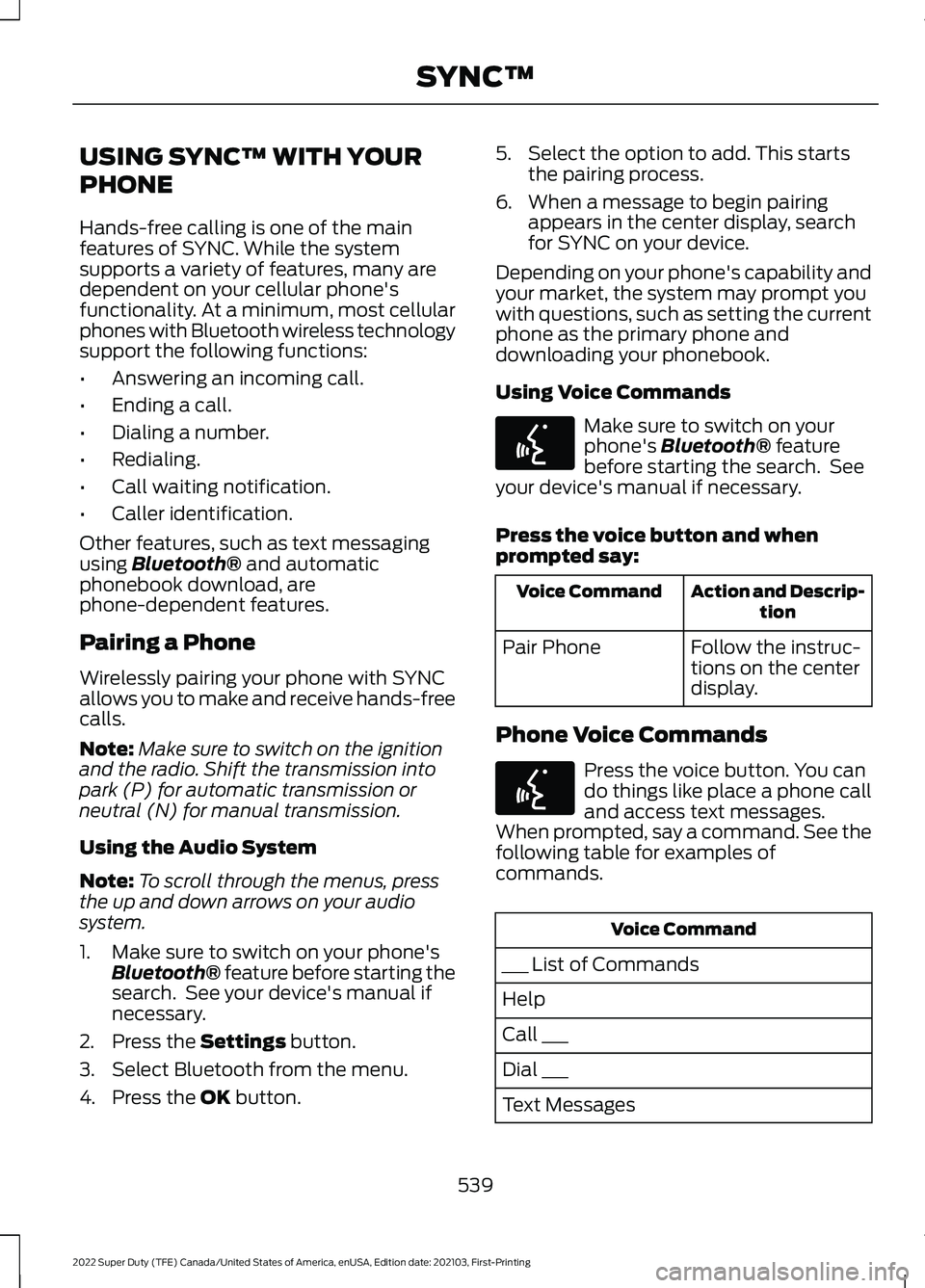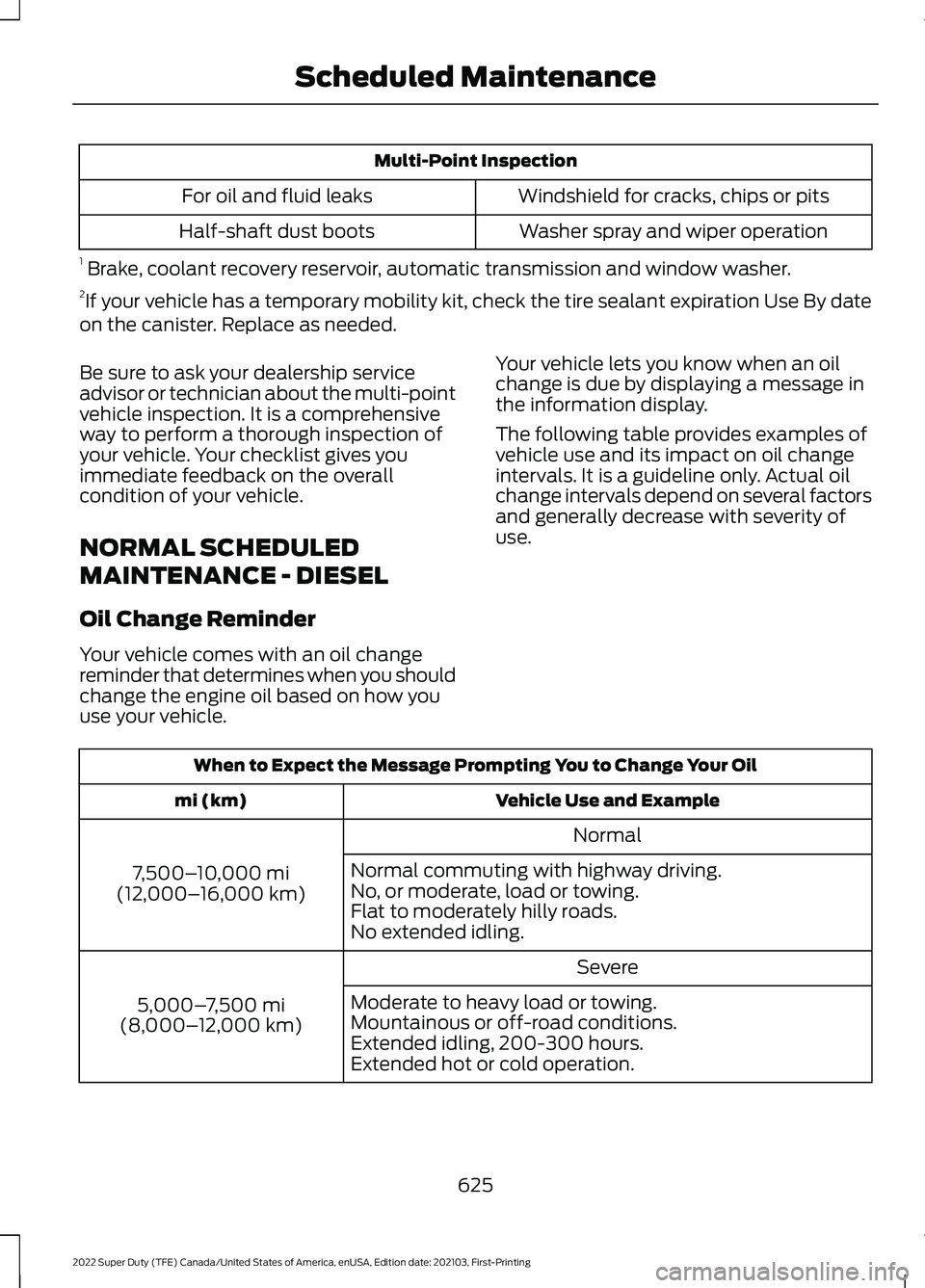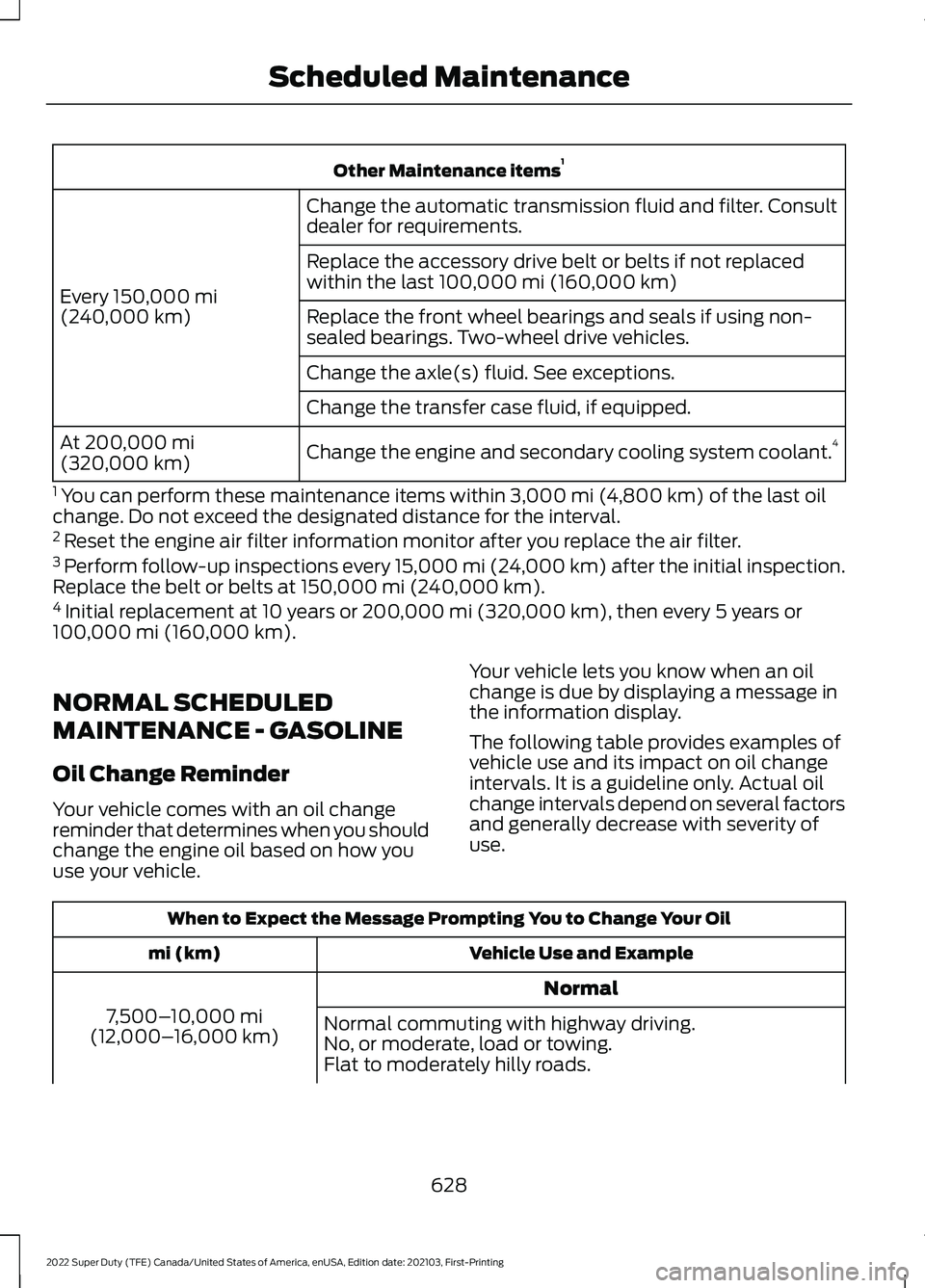2022 FORD F-250 automatic transmission
[x] Cancel search: automatic transmissionPage 499 of 740

HYDRAULIC POWER
STEERING FLUID CAPACITY
AND SPECIFICATION
Use fluid that meets the defined
specification.
If you do not use fluid that meets the
defined specification, it could result in:
•
Component damage that your vehicle
warranty does not cover.
• Reduced vehicle performance.
Capacities Quantity
Variant
Fill as required.
All.
Materials Specification
Name
WSS-M2C938-AMERCON® LV,
Motorcraft® MERCON® LV Automatic Transmission
Fluid(U.S.)
Motorcraft® MERCON® LV Automatic Transmission
Fluid / Huile pour boîte automatique MERCON® LV
Motorcraft®(Canada)
XT-10-QLVC(U.S.)
CXT-10-LV6(Canada)
496
2022 Super Duty (TFE) Canada/United States of America, enUSA, Edition date: 202103, First-Printing Capacities and Specifications
Page 542 of 740

USING SYNC™ WITH YOUR
PHONE
Hands-free calling is one of the main
features of SYNC. While the system
supports a variety of features, many are
dependent on your cellular phone's
functionality. At a minimum, most cellular
phones with Bluetooth wireless technology
support the following functions:
•
Answering an incoming call.
• Ending a call.
• Dialing a number.
• Redialing.
• Call waiting notification.
• Caller identification.
Other features, such as text messaging
using Bluetooth® and automatic
phonebook download, are
phone-dependent features.
Pairing a Phone
Wirelessly pairing your phone with SYNC
allows you to make and receive hands-free
calls.
Note: Make sure to switch on the ignition
and the radio. Shift the transmission into
park (P) for automatic transmission or
neutral (N) for manual transmission.
Using the Audio System
Note: To scroll through the menus, press
the up and down arrows on your audio
system.
1. Make sure to switch on your phone's Bluetooth® feature before starting the
search. See your device's manual if
necessary.
2. Press the
Settings button.
3. Select Bluetooth from the menu.
4. Press the
OK button. 5. Select the option to add. This starts
the pairing process.
6. When a message to begin pairing appears in the center display, search
for SYNC on your device.
Depending on your phone's capability and
your market, the system may prompt you
with questions, such as setting the current
phone as the primary phone and
downloading your phonebook.
Using Voice Commands Make sure to switch on your
phone's
Bluetooth® feature
before starting the search. See
your device's manual if necessary.
Press the voice button and when
prompted say: Action and Descrip-
tion
Voice Command
Follow the instruc-
tions on the center
display.
Pair Phone
Phone Voice Commands Press the voice button. You can
do things like place a phone call
and access text messages.
When prompted, say a command. See the
following table for examples of
commands. Voice Command
___ List of Commands
Help
Call ___
Dial ___
Text Messages
539
2022 Super Duty (TFE) Canada/United States of America, enUSA, Edition date: 202103, First-Printing SYNC™E142599 E142599
Page 628 of 740

Multi-Point Inspection
Windshield for cracks, chips or pits
For oil and fluid leaks
Washer spray and wiper operation
Half-shaft dust boots
1 Brake, coolant recovery reservoir, automatic transmission and window washer.
2 If your vehicle has a temporary mobility kit, check the tire sealant expiration Use By date
on the canister. Replace as needed.
Be sure to ask your dealership service
advisor or technician about the multi-point
vehicle inspection. It is a comprehensive
way to perform a thorough inspection of
your vehicle. Your checklist gives you
immediate feedback on the overall
condition of your vehicle.
NORMAL SCHEDULED
MAINTENANCE - DIESEL
Oil Change Reminder
Your vehicle comes with an oil change
reminder that determines when you should
change the engine oil based on how you
use your vehicle. Your vehicle lets you know when an oil
change is due by displaying a message in
the information display.
The following table provides examples of
vehicle use and its impact on oil change
intervals. It is a guideline only. Actual oil
change intervals depend on several factors
and generally decrease with severity of
use.When to Expect the Message Prompting You to Change Your Oil
Vehicle Use and Example
mi (km)
Normal
7,500– 10,000 mi
(12,000– 16,000 km) Normal commuting with highway driving.
No, or moderate, load or towing.
Flat to moderately hilly roads.
No extended idling.
Severe
5,000– 7,500 mi
(8,000– 12,000 km) Moderate to heavy load or towing.
Mountainous or off-road conditions.
Extended idling, 200-300 hours.
Extended hot or cold operation.
625
2022 Super Duty (TFE) Canada/United States of America, enUSA, Edition date: 202103, First-Printing Scheduled Maintenance
Page 631 of 740

Other Maintenance items
1
Change the automatic transmission fluid and filter. Consult
dealer for requirements.
Every 150,000 mi
(240,000 km) Replace the accessory drive belt or belts if not replaced
within the last 100,000 mi (160,000 km)
Replace the front wheel bearings and seals if using non-
sealed bearings. Two-wheel drive vehicles.
Change the axle(s) fluid. See exceptions.
Change the transfer case fluid, if equipped.
Change the engine and secondary cooling system coolant. 4
At
200,000 mi
(320,000 km)
1 You can perform these maintenance items within
3,000 mi (4,800 km) of the last oil
change. Do not exceed the designated distance for the interval.
2 Reset the engine air filter information monitor after you replace the air filter.
3 Perform follow-up inspections every 15,000 mi (24,000 km) after the initial inspection.
Replace the belt or belts at
150,000 mi (240,000 km).
4 Initial replacement at 10 years or 200,000 mi (320,000 km), then every 5 years or
100,000 mi (160,000 km).
NORMAL SCHEDULED
MAINTENANCE - GASOLINE
Oil Change Reminder
Your vehicle comes with an oil change
reminder that determines when you should
change the engine oil based on how you
use your vehicle. Your vehicle lets you know when an oil
change is due by displaying a message in
the information display.
The following table provides examples of
vehicle use and its impact on oil change
intervals. It is a guideline only. Actual oil
change intervals depend on several factors
and generally decrease with severity of
use.When to Expect the Message Prompting You to Change Your Oil
Vehicle Use and Example
mi (km)
Normal
7,500– 10,000 mi
(12,000– 16,000 km) Normal commuting with highway driving.
No, or moderate, load or towing.
Flat to moderately hilly roads.
628
2022 Super Duty (TFE) Canada/United States of America, enUSA, Edition date: 202103, First-Printing Scheduled Maintenance
Page 633 of 740

Brake Fluid Maintenance
1
Change the brake fluid. 2
Every three years
1 Perform this maintenance item every three years. Do not exceed the designated time
for the interval.
2 Brake fluid servicing requires special equipment available at your authorized dealer. Other Maintenance Items
Replace the cabin air filter.
Every 20,000 mi
(32,180 km)
Replace the engine air filter.
Every
30,000 mi
(48,000 km)
Replace the front wheel bearing grease and grease seal, if
you use non-sealed bearings.
Every
60,000 mi
(96,000 km)
Replace the spark plugs.
Every
100,000 mi
(160,934 km)
Inspect the accessory drive belt or belts. 1
Every
100,000 mi
(160,934 km)
Change the automatic transmission fluid and filter on 6-speed
transmission. Consult dealer for requirements.
Every
150,000 mi
(240,000 km) Replace the accessory drive belt or belts if not replaced within
the last 100,000 mi (160,000 km).
Replace the front wheel bearings and seals if you use non-
sealed bearings.
Change the axle(s) fluid. See exceptions.
Change the transfer case fluid, if applicable.
Change the engine coolant. 2
At
200,000 mi
(320,000 km)
1 If not replaced, inspect the belt or belts every
15,000 mi (24,000 km).
2 Initial replacement at 10 years or 200,000 mi (320,000 km), then every 5 years or
100,000 mi (160,000 km).
630
2022 Super Duty (TFE) Canada/United States of America, enUSA, Edition date: 202103, First-Printing Scheduled Maintenance
Page 722 of 740

Automatic Locking Mode.............................51
Disengaging Automatic Locking Mode........52
Engaging Automatic Locking Mode..............52
What Is Automatic Locking Mode................... 51
When to Use Automatic Locking Mode........51
Automatic Transmission...........................224 Automatic Transmission Positions.............224
Brake Shift Interlock......................................... 225
Manually Shifting Gears.................................. 225
Power Take-Off................................................... 227
Automatic Transmission Fluid Capacity and Specification - Diesel
.....................487
Automatic Transmission Fluid Capacity and Specification - Gasoline................487
Automatic Transmission Positions.......224 Drive (D)................................................................ 224
Manual (M).......................................................... 224
Neutral (N)........................................................... 224
Park (P)................................................................. 224
Reverse (R).......................................................... 224
Automatic Transmission Precautions.................................................224
Auto Mode
........................................................151
Auto Mode Indicators......................................... 151
Switching Auto Mode On and Off.................151
Switching Dual Mode On and Off.................152
Autounlock.......................................................84 Autounlock Requirements................................ 84
Switching Autounlock On and Off................84
What Is Autounlock............................................. 84
Autowipers.......................................................115 Adjusting the Sensitivity of the Rain
Sensor................................................................. 115
Autowipers Settings........................................... 115
What Are Autowipers......................................... 115
Auxiliary Switches........................................616
B
Battery See: Changing the 12V Battery.................... 409
Bed Extender...................................................96 Bed Extender Precautions................................ 96
Using the Bed Extender..................................... 97
Beginning a Voice Interaction................600
Blind Spot Information System.............293 Blind Spot Information System –
Troubleshooting............................................ 297Blind Spot Information System With Trailer
Coverage.......................................................... 295
Blind Spot Information System Indicators.....................................................296
Blind Spot Information System Limitations..................................................293
Blind Spot Information System Precautions.................................................293
Blind Spot Information System Requirements.............................................293
Blind Spot Information System – Troubleshooting........................................297
Blind Spot Information System – Information Messages................................. 297
Blind Spot Information System With Trailer Coverage
........................................295
Blind Spot Information System With Trailer
Coverage Limitations.................................. 295
Selecting a Trailer.............................................. 296
Setting a Trailer Length................................... 295
What Is Blind Spot Information System with Trailer Coverage............................................. 295
Bluetooth®....................................................607
Body Control Module Fuse Box..............392 Accessing the Body Control Module Fuse
Box...................................................................... 392
Identifying the Fuses in the Body Control Module Fuse Box.......................................... 393
Locating the Body Control Module Fuse Box...................................................................... 392
Bonnet Lock See: Opening and Closing the Hood..........396
Booster Seats
..................................................46
Brake Fluid Specification...........................241
Brake Over Accelerator
.............................240
Brake Precautions.......................................240
Brakes..............................................................240
Anti-Lock Braking System............................. 240
Brakes – Troubleshooting............................... 241
Brake Shift Interlock
...................................225
Brake Shift Interlock Precautions................225
Using Brake Shift Interlock............................. 226
What Is Brake Shift Interlock......................... 225
Brakes – Troubleshooting
.........................241
Brakes – Frequently Asked
Questions.......................................................... 241
Brakes – Warning Lamps................................. 241
Breaking-In.....................................................373
719
2022 Super Duty (TFE) Canada/United States of America, enUSA, Edition date: 202103, First-Printing Index